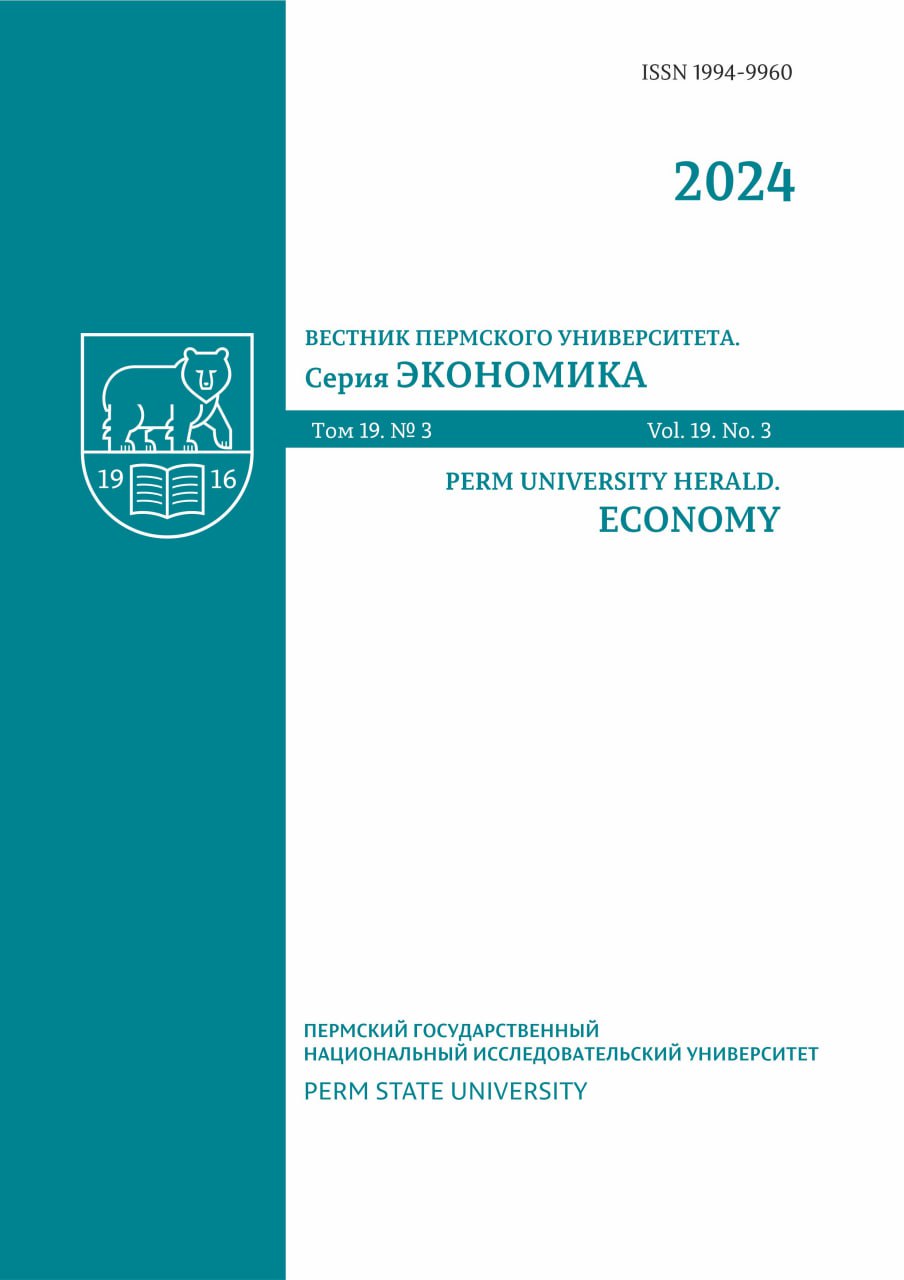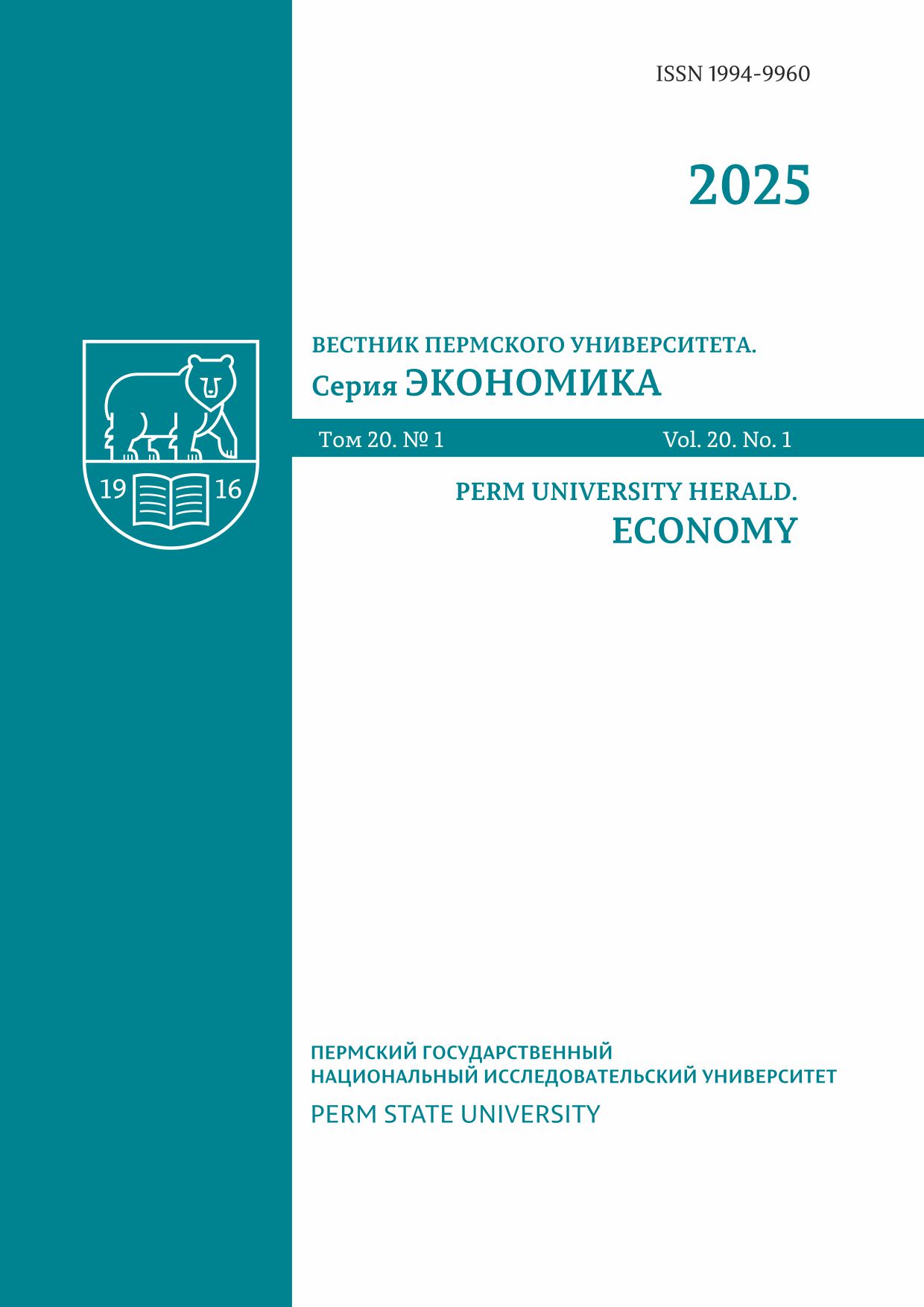Analyzing the impact of asymmetric shocks on the interaction strategies between the monetary authorities of two countries
DOI:
https://doi.org/10.17072/1994-9960-2025-1-42-56Abstract
Introduction. Stronger interdependence of countries driven by the international trade gives rise to a relevant question whether there is a need for each country to pursue its independent monetary policies or whether it is advisable to coordinate these policies. In other words, the question of whether we should consider the benefits from harmonizing international monetary policies becomes a key issue in the debate about the appropriate monetary policy strategies in open economies. Purpose. The objective of this study is to analyze the impact of asymmetric aggregate demand shocks on the need for monetary policy coordination in a simple stochastic model of two interacting countries. Materials and Methods. The authors analyze the equilibrium states of the examined interaction strategies between the monetary authorities with an analytical method by minimizing the loss function and solving sequential statistical problems of optimization. Results. The equilibrium states of the macroeconomies for interacting countries have been looked at when the monetary policies are coordinated and when they are not coordinated (the Nash and Stackelberg equilibrium) under asymmetric serially uncorrelated demand shocks. The response of inflation to asymmetric demand shocks is proven to be less for the Nash coordinated policy than for non-coordinated policy. This is opposite to the result obtained under symmetric supply shocks. The loss function analysis shows that the compensation of demand shocks is found to be more costly in the Nash equilibrium than under the coordination policy practiced by monetary authorities. The analysis of the monetary authorities’ interaction strategies showed that the real exchange rate plays an important role in balancing supply and demand in the two economies. Conclusions. The key finding of the study is that asymmetric shocks affect the evaluation of interaction strategies practiced by monetary authorities. The practical significance of the results lies in the fact that monetary authorities could stabilize the economy by creating buffers against external shocks.
Keywords: coordination policy, the Nash equilibrium, the Stackelberg strategy, real exchange rate, asymmetric shocks, inflation rate
Funding
The work was funded under the research plan of the Institute of Economics of the Ural Branch of the Russian Academy of Sciences.
For citation
Serkov L. A. Analyzing the impact of asymmetric shocks on the interaction strategies between the monetary authorities of two countries. Perm University Herald. Economy, 2025, vol. 20, no. 1, pp. 42–56. DOI 10.17072/1994-9960-2025-1-42-56. EDN YJVWCM.
References
- Mundell R. A theory of optimum currency areas. American Economic Review, 1961, vol. 51, pp. 657–675.
- McKibbin W. Empirical evidence on international economic policy coordination. Handbook of Comparative Economic Policies, 1997, vol. 5, pp. 148–176.
- Obstfeld M., Rogoff K. Global implications of self-oriented national monetary rules. Quarterly Journal of Economics, 2002, vol. 117, pp. 503–536. DOI 10.1162/003355302753650319
- Corsetti G., Pesenti P. The International dimension of optimal monetary policy. Journal of Monetary Economics, 2005, vol. 52, iss. 2, pp. 281–305. DOI 10.1016/j.jmoneco.2004.06.002
- Obstfeld M., Rogoff K. Do we really need a new international monetary compact? NBER Working Paper No. 7864. NBER, 2000. 38 p. DOI 10.3386/w7864
- Canzoneri M., Henderson D. Monetary policy in interdependent economies: A game-theoretic approach. Cambridge, MIT Press, 1992. 180 p.
- Canzoneri M., Cumby R., Diba B. The need for international policy coordination: What’s old, what’s new, what’s yet to come? Journal of International Economics, 2005, vol. 66, pp. 363–384. DOI 10.1016/j.jinteco.2004.03.005
- Chari V., Kehoe P. International coordination of fiscal policy in limiting Economies. Journal of Political Economy, 1990, vol. 98, no. 3, pp. 617–636. DOI 10.1086/261697
- Imisiker S., Tas B. International monetary policy coordination through communication: Chasing the Loch Ness Monster. International Journal of Central Banking, 2019, vol. 15, no. 2, pp. 301–321.
- Zheng L., Pappa E. Gains from international monetary Policy Coordination. Does it pay to be different? Working paper series No. 514. European Central Bank, 53 p.
- Persson T., Tabellini G. International monetary policy coordination. Hallett A. H., Mooslechner P., Schuerz M. (eds) Challenges for Economic Policy Coordination within European Monetary Union. Boston, MA: Springer, 2001, pp. 27–43. DOI 10.1007/978-1-4757-4738-6_2
- Corsetti G., Dedola L., Leduc S. Optimal monetary policy in open economies. Handbook of Monetary Economics, 2011, vol. 3, pp. 861–933. DOI 10.1016/B978-0-444-53454-5.00004-9
- Bacchetta P., van Wincoop E. Can information heterogeneity explain the exchange rate determination puzzle? American Economic Review, 2006, vol. 96, no. 3, pp. 552–576. DOI 10.1257/aer.96.3.552
- Bacchetta P., van Wincoop E. On the unstable relationship between exchange rates and macroeconomic fundamentals. Journal of International Economics, 2013, vol. 91, iss. 1, pp. 18–26. DOI 10.1016/j.jinteco.2013.06.001
- Kydland F., Prescott E. Time to build and aggregate fluctuations. Econometrica, 1982, vol. 50, no. 6, pp. 1345–1370. DOI 10.2307/1913386
- An S., Schorfheide F. Bayesian analysis of DSGE models. Econometric Reviews, 2007, vol. 26, iss. 2-4, pp. 113–172. DOI 10.1080/07474930701220071
- Sims C. Solving rational expectations models. Computational Economics, 2002, vol. 20, pp. 1–20. DOI 10.1023/A:1020517101123
- Coenen G., Lombardo G., Smets F., Straub R. International transmission and monetary policy cooperation. ECB Working Paper No. 858. 2008. 48 p. DOI 10.2139/ssrn.1082739
- Benigno P. A Simple approach to international monetary policy coordination. Journal of International Economics, 2002, vol. 57, iss. 1, pp. 177–196. DOI 10.1016/S0022-1996(01)00132-5
- Basu S., Bundick B. Uncertainty shocks in a model of effective demand. NBER Working Paper No. 18420. 2012. 39 p. DOI 10.3386/w18420
- Leduc S., Liu Z. Uncertainty shocks are aggregate demand shocks. Working Paper No. 2012-10. Federal Reserve Bank of San Francisco, 2015. 44 p.
- Carriere-Swallow Y., Cespedes L. The impact of uncertainty shocks in emerging economies. Journal of International Economics, 2013, vol. 90, iss. 2, pp. 316–325. DOI 10.1016/j.jinteco.2013.03.003
- Golodova Zh., Ranchinskaya Yu., Gorokhova E. Aspects of monetary policy in the EEU countries: An analysis of the prerequisites for harmonization. National Interests: Priorities and Security, 2016, no. 7, pp. 78–89. (In Russ.). EDN WFJZLH
- Golodova Zh. Bankovskie sistemy stran SNG: sovremennye tendentsii i antikrizisnoe regulirovanie. Den'gi i kredit, 2010, no. 1, pp. 36–45. (In Russ.). EDN KYDZHF
- Pekarski S. Macroeconomic policy coordination: The case of unstable inflation and public debt dynamics. Higher School of Economics Economic Journal, 2001, no. 4, pp. 492–518. (In Russ.). EDN USURIS
- Pekarski S., Atamanchuk M., Merzlyakov S. Strategicheskoe vzaimodeistvie fiskal'noi i monetarnoi politiki v eksportno orientirovannoi ekonomike. Den'gi i kredit, 2010, no. 2, pp. 52–63. (In Russ.). EDN KZBCXX
- Walsh C. Monetary theory and policy. Cambridge, MIT Press, 2003. 611 p.
- Kontorovich V. К. The relationship between real exchange rate and industrial growth in Russia. Higher School of Economics Economic Journal, 2001, no. 3, pp. 363–374. (In Russ.). EDN ZSSAUP
- Kudrin А. Ruble real effective exchange rate: Problems of appreciation. Voprosy ekonomiki, 2006, no. 10, pp. 4–18. (In Russ.). DOI 10.32609/0042-8736-2006-10-4-18. EDN JVIXFN
- Jeanne O. Macroprudential policies in a global perspective. NBER Working Paper No. 19967. 2014. 32 p. DOI 10.3386/w19967











